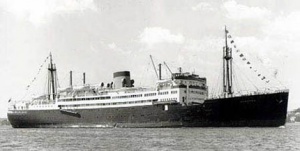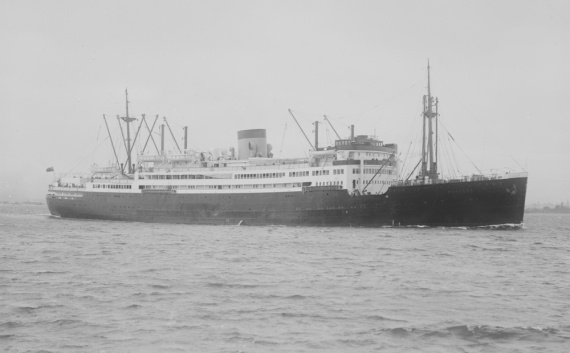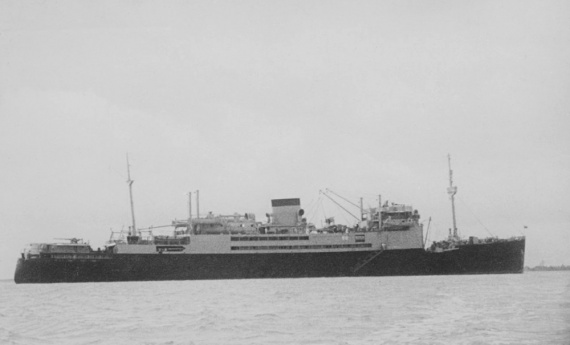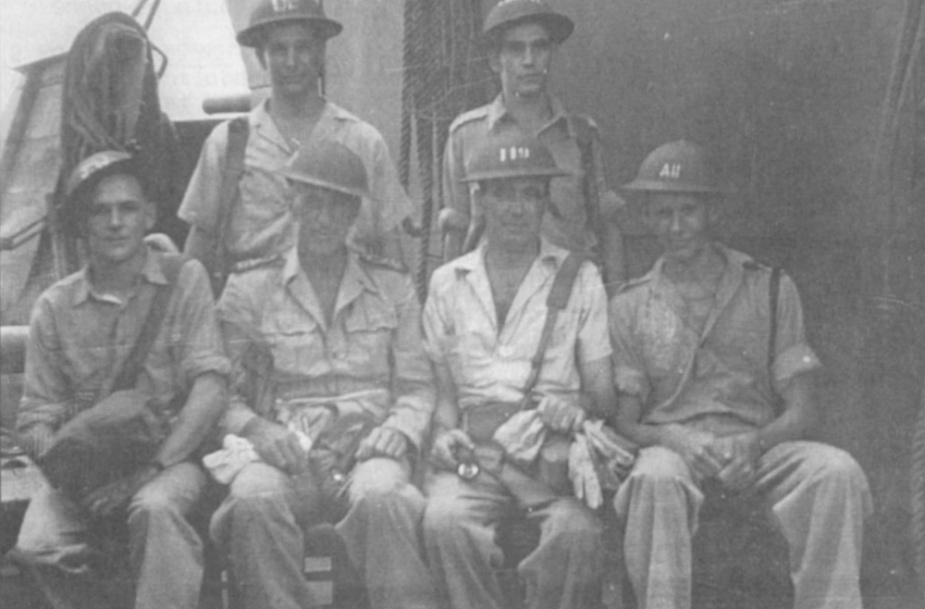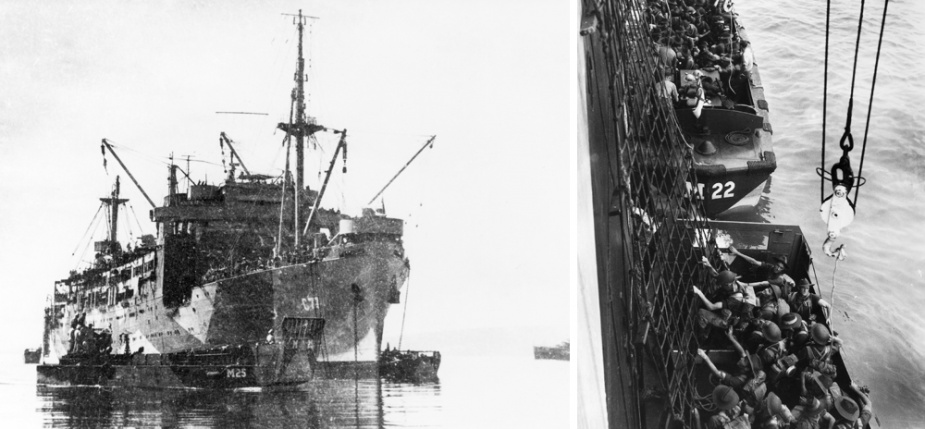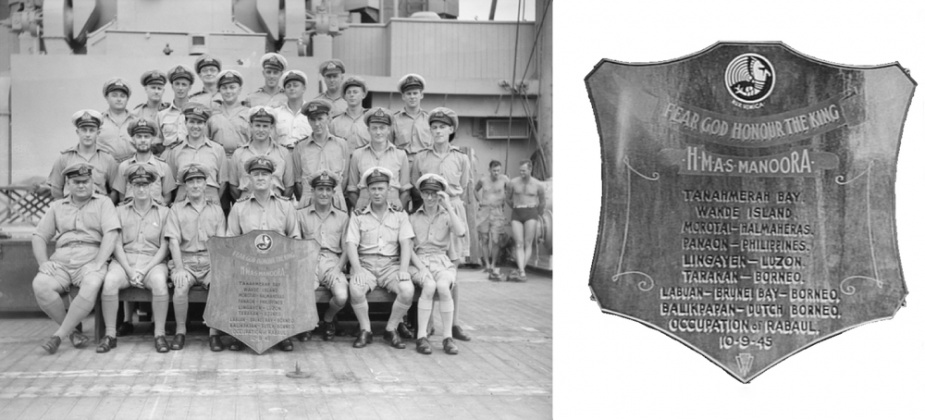HMAS Manoora (I)
| Type |
Armed Merchant Cruiser/Landing Ship Infantry |
|---|---|
| Pennant |
F48 |
| Builder |
Alex Stephen and Sons Ltd |
| Launched |
24 October 1934 |
| Commissioned |
12 December 1939 |
| Decommissioned |
6 December 1947 |
| Dimensions & Displacement | |
| Displacement | 10,856 tons gross |
| Length | 480 feet |
| Beam | 66 feet 3 inches |
| Draught | 24 feet |
| Performance | |
| Speed | 15.7 knots |
| Complement | |
| Crew | 345 |
| Propulsion | |
| Machinery | Diesels, twin screws |
| Armament | |
| Guns |
|
| Other Armament | 1 x Seagull V aircraft |
| Awards | |
| Battle Honours | |

The motor vessel Manoora was built for the Adelaide Steamship Company and entered service on the Cairns to Fremantle run in 1935. The name Manoora was derived from the name of a large sheep station in South Australia owned by Sir Walter Duncan, a Director of the Adelaide Steamship Company. The ship's emblem was a seahorse with the motto 'Nux Vomica', a shrub grown in Ceylon from which the poison strychnine is procurred. The accepted translation is 'Never Fails' or 'Hands Off, I'm Poison'.
Following the outbreak of war she was requisitioned by the Royal Australian Navy on 11 October 1939 and outfitted in Sydney for service as an Armed Merchant Cruiser.
HMAS Manoora commissioned on 12 December 1939 under the command of Commander Arthur Spurgeon, RAN and her conversion completed on 5 February 1940. A series of sea trials and exercises were conducted in Port Phillip Bay before she returned to Sydney before proceeding to northern Queensland waters.
After conducting further exercises off the Queensland coast and in the Coral Sea, Manoora sailed for Macassar where she arrived on 1 April to conduct patrols to prevent the breakout of German merchant ships from Dutch East Indies ports. Due to the threat of German invasion of Denmark and Norway on 9 April it was necessary to ensure that the merchant vessels of those countries came under Allied control. To this end Manoora intercepted and boarded the Norwegian tanker Havbor and escorted her to Darwin. She then escorted Havbor and another Norwegian tanker, Thordis, to Thursday Island where two further Norwegian vessels were rounded up and escorted to Brisbane.
For the next three months Manoora operated mainly in New Guinea and north eastern Australian waters. With the likelihood of Italy entering the war on the side of Germany, Commander Spurgeon received orders to shadow the Italian liner Romolo (Captain Gavino) which had departed Brisbane on 5 June. When, by the morning of 9 June, Italy's intentions were still unclear and the shadowing might continue indefinitely, the operation was called off.
At 09:00 on 11 June 1940, Eastern Australian time, war with Italy began and Spurgeon received orders to relocate Romolo and intercept her. By that time the Italian liner was 160 miles away, steering north east. She was eventually sighted by Manoora on the morning of 12 June approximately 220 miles south west of Nauru. Spurgeon signaled by lamp to the Italian vessel to stop and made by wireless:
Stop instantly or I will fire. Do not attempt to sink ship. Do not abandon ship because I will not pick you up.
Romolo acknowledged the signal and replied 'OK' but continued on her course. She was beyound gun range of Manoora and at 12:30 she was obscured from view by a rain squall. When she was sighted 15 minutes later Romolo was stopped and listing to port, her boats were lowered and she was on fire, burning violently. Manoora closed her position but Spurgeon determined not to send a boarding party over to her owing to the danger posed to his personnel. It was clear to Spurgeon that Romolo was not able to be salvaged and his efforts thereafter were directed towards rescuing her passengers and crew. In all some 129 souls were picked up, unhurt, before Manoora fired seven rounds into her to speed her on her way.
As darkness fell she made an inspiring sight, on fire, down by the stern with the poop submerged. She lurched to starboard, and her bulkheads gave with a muffled report, and she sank stern first very suddenly.
At 19:15 Romolo disappeared from view in position 2 degrees 20 minutes south, 163 degrees 45 minutes east, approximately 220 miles south-west of Nauru Island.
On board Manoora the passengers and crew of Romolo were made comfortable in cabins, the wardroom and public rooms. The Italian cooks were given a section of the galley and cooked for their own people, and the opportunity was taken of getting some instruction in baking for the ship's baker from the Italian pastry cooks.
As she returned to Australia Manoora had one more task to perform. The American merchant vessel Admiral Wiley had run aground on Kitava Island in the Trobriands and Spurgeon was directed to proceed there and render assistance. Manoora arrived there on 15 June but there was nothing that could be done to help the stranded ship other than take off her crew of seven officers and twenty four ratings. She reached Townsville on 17 June.
On completion of a minor refit Manoora sailed for Fremantle where she was stationed throughout most of August until the middle of October. There she performed convoy and escort duties in western waters before relocating to Darwin where she undertook patrols around Darwin, Thursday Island and Port Morseby.
Between December 1940 and February 1941 Manoora patrolled New Guinea waters as well as conducting a number of sweeps to Nauru and Ocean Islands following reports of German raiders operating in the vicinity. On 13 February 1941 she returned to Sydney for a reft before resuming this pattern of patrol work until November.
Following a further refit in November Manoora sailed from Sydney for Singapore, arriving there on 6 December. After the entry of Japan into the war, Manoora was employed on patrol and escort duties between India, Ceylon and Burma until March 1942, when she returned to Australia as part of the escort of Convoy SU.1, the first of the 'Stepsister' convoys returning Australian troops from the Middle East.
After reaching Melbourne on 23 March 1942 Manoora remained in port until 17 April at which time she escorted a convoy to Noumea before returning to Sydney on 27 April. She made a return trip to Noumea in May, as the escort for the mine-layer HMAS Bungaree, before undergoing further maintenance in Sydney.
On 29 June 1942 Acting Commander Thomas Gower, RAN assumed command and between 4 July and 29 September Manoora undertook escort duties between Sydney and Fremantle before being placed in the hands of the dockyard for conversion to a Landing Ship Infantry (LSI). On 2 February 1943 Manoora recommissioned. Her conversion was completed in March which saw her equipped with the British system of mess decks and hammocks for troops on board. This limited her troop accommodation to about 850 and later she was retrofitted with American pattern messing that saw standee bunks installed, increasing troop capacity to approximately 1250. LSI Manoora carried between 20-22 Landing Craft Vehicle Personnel (LCVP) and 2-3 Landing Craft Mechanised (LCM).
The strategic concept of the campaign to drive the Japanese from their positions in the South-West Pacific was based on amphibious operations and, in the second half of 1942, an amphibious warfare section was organised in the American Navy Department by Rear Admiral DE Barbey, USN. At the end of the year he was appointed in command of VII Amphibious Force and he proceeded to Australia where Manoora was the first ship to join the force.
In March 1943 Manoora proceeded to Port Stephens for a few days, where an amphibious training facility had been established, before returning to Sydney. She then departed for Melbourne where, until mid June, she was involved in further amphibious training exercises with United States troops.
Acting Captain Cecil Baldwin, MVO, RAN assumed command of Manoora on 29 June 1943 and throughout July she operated in the Sydney/Port Stephens after which she departed for Milne Bay transporting Australian troops.
Manoora returned to Port Stephens on 16 August remaining there until 2 October. She then visited Sydney and, after again returning to Port Stephens for a short stay, transported troops to Oro Bay, New Guinea, a voyage she repeated early in November. During this period she also carried out landing exercises in the Cairns area. On 15 December she commenced a major refit at Garden Island.
On 27 January 1944 Acting Captain Alan Cousin, RANR (S) assumed command of Manoora. The refit completed on 9 February 1944 and from March to June 1944 Manoora was in New Guinea waters. On 22 April, in company with the landing ship infantry HMAS Kanimbla (I) and four other transports, 16 landing craft infantry and seven landing ships tank, she landed troops at Tanahmerah Bay without incident. On 17 May Manoora landed troops of the American 41st Division on Wakde Island.
In early September 1944 Manoora and Kanimbla (I) prepared for the Morotai landings. On 10 September Manoora embarked 1272 men at Maffin Bay. The ships then sailed to Morotai. The landings took place on 15 September with little opposition and few casualties to the Allied forces. On the 16th Manoora and Kanimbla (I) departed for Humboldt Bay, arriving on the 18th.
At Humboldt Bay Manoora and Kanimbla (I), joined by the third Australian landing ship infantry, HMAS Westralia (I), overhauled equipment and embarked troops and supplies for the landings on Leyte. A full scale rehearsal was carried out at Tanahmerah Bay on 10 October. On 13 October the three Australian LSIs departed for Leyte as part of a large assault convoy escorted by a covering force of American and Australian cruisers and destroyers. The Australian landing ships were part of the Panaon Attack Group which detached from the main group at 02:00 on the morning of 20 October arriving off Panaon at 08:45. No Japanese resistance was encountered. Cargo was discharged by 16:00 and the ships sailed for Humboldt Bay arriving on 25 October.
During November the three LSIs were engaged in transporting troops from Humboldt Bay to Leyte. On 30 November they, and 15 other ships designated Transport Group 'A', commenced embarking troops and stores for the Lingayen landings. Transport Group 'A' then proceeded to Lae where, in company with Landing Group 'B', practice landings were carried out. The ships then sailed for Manus Island. On 31 December they departed Manus to execute Assault Mike I on Luzon Island in Lingayen Gulf.
As part of Task Force 79, the Lingayen Attack Force, Kanimbla (I), Manoora and Westralia (I) passed through Surigao Strait and proceeded up the western side of the Philippine Archipelago to Lingayen Gulf, arriving on 8 January 1945. As the ships made their final approach to the gulf they came under air attack, one aircraft being shot down by Westralia (I). The troops were landed on 9 January, supported by a heavy bombardment. The LSIs discharged their cargoes rapidly and left the area that evening to avoid further air attack, returning via Leyte to Morotai.
Morotai
Manoora arrived at Morotai Island in the Halmahera group, of what is today Indonesia's Maluku Islands, on 21 January 1945, wearing a new paint scheme. Following the landings at Lingayen Gulf a decision was made to apply camouflage paint schemes to all three Australian landing ships infantry. Commander Cousins, the captain of Manoora, highlighted this in his Report of Proceedings for February 1945 as follows:
For some considerable time it has been felt that Manoora, Kanimbla and Westralia, being painted dark grey - almost black, were most conspicuous in a convoy, the great majority of which carry camouflage painting. Also, the very dark colour tended to exaggerate the size of the Australian landing ships infantry. While at the Lingayen Gulf assault of 9 January numerous remarks were received from officers onshore on the manner in which the dark hulls of Australian landing ships infantry stood out clearly and distinctly amongst the other ships in the vicinity which included camouflaged United States battleships. The cruisers Australia and Shropshire stood out very clearly as viewed from Manoora, and later in the afternoon, after the Australia had been apparently picked out and struck in the foremost funnel by a suicide plane, a signal was sent to Australia commenting on this fact. On return to Leyte on 12th it was decided to paint all three Australian landing ships infantry in a camouflage design to the individual Commanding Officer's approval.
It was also at Morotai that a member of Manoora's crew fell victim to misadventure during one of several periods of shore leave granted to the ship's company. By February 1945 the RAAF was launching operational sorties from an airstrip on Morotai and unknown to authorities on board Manoora, ratings, eager for some excitement, managed to persuade the RAAF pilots into allowing them to accompany them on operational sweeps over enemy held islands in the Celebes. For several days sailors joined their air force counterparts on these exceedingly dangerous missions until tragedy struck when a Beaufighter from 31 Squadron, in which Sick Berth Attendant Alec Hill had "hitched a ride", was shot down by Japanese anti-aircraft fire. The pilot, Pilot Officer William McGuigan, and Hill survived a force landing in the sea but Flight Sergeant Allan Lewis did not. Both men made it safely ashore but were subsequently captured by the Japanese becoming prisoners of war. Following four months in captivity at Tonsea Lama the pair were transferred to the Japanese Naval Prison at Manado. A few days later, on 19 June 1945, they were taken from the prison and executed by bayoneting at the same time as two Dutchmen and two Indonesians. The discovery was made following the cessation of hostilities and Hill's remains were subsequently buried in the Morotai War Cemetery on 9 November 1945. Over the ensuing decades the war graves were relocated on two occasions and SBA Hill now rests in Plot 28 Row D Grave 5 in the Commonwealth War Cemetery at Ambon. He was to be Manoora's only death through enemy action during the war.
Manoora and Westralia (I) were then engaged in the Australian landings on Tarakan. Embarking Australian units for the first time, the LSIs sailed from Morotai on 27 April 1945, each ship towing a Landing Craft Tank (LCT). The transport force arrived off Tarakan on 30 April and the LCTs were slipped. The troops were successfully landed on 1 May and the ships finished discharging their cargoes the next day. They then departed for Morotai where further stores were loaded and brought forward to the landing beaches.
The LSIs' next operation was the invasion of Brunei. Departing from Morotai on 4 June in company with a large group of American vessels, mostly landing ships and landing craft, they arrived off Brunei on 10 June and commenced landing their troops on Green Beach just before 09:00 with little or no opposition. They unloaded their cargo that day before steaming to Morotai on 11 May, arriving there on 14 May.

